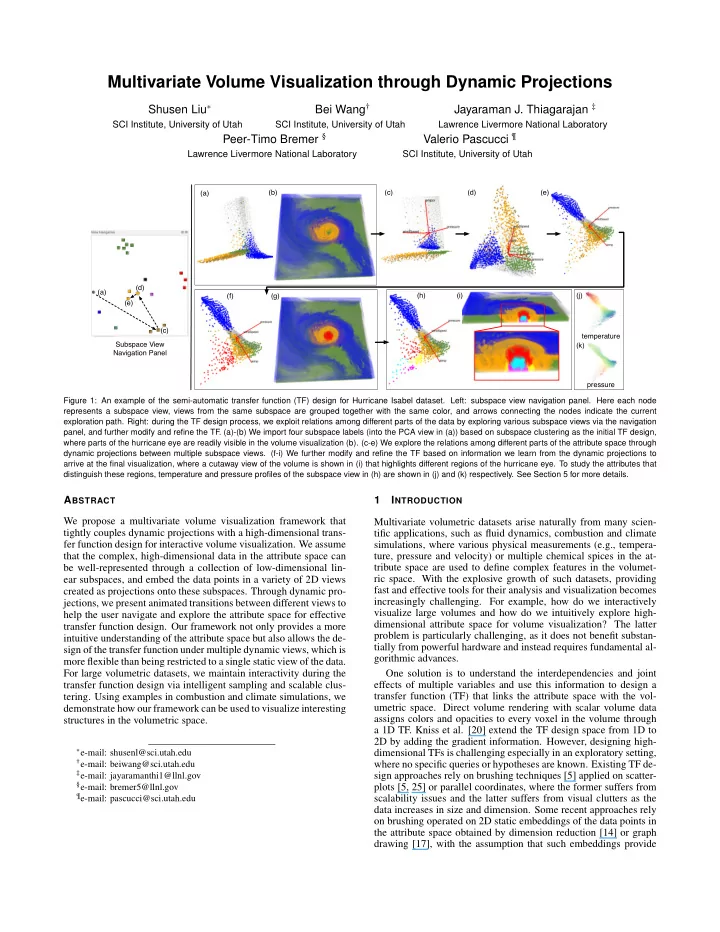

Multivariate Volume Visualization through Dynamic Projections Bei Wang † Jayaraman J. Thiagarajan ‡ Shusen Liu ∗ SCI Institute, University of Utah SCI Institute, University of Utah Lawrence Livermore National Laboratory Peer-Timo Bremer § Valerio Pascucci ¶ Lawrence Livermore National Laboratory SCI Institute, University of Utah (b) (c) (d) (e) (a) (d) (a) (f) (g) (h) (i) (j) (e) (c) temperature Subspace View (k) Navigation Panel pressure Figure 1: An example of the semi-automatic transfer function (TF) design for Hurricane Isabel dataset. Left: subspace view navigation panel. Here each node represents a subspace view, views from the same subspace are grouped together with the same color, and arrows connecting the nodes indicate the current exploration path. Right: during the TF design process, we exploit relations among different parts of the data by exploring various subspace views via the navigation panel, and further modify and refine the TF . (a)-(b) We import four subspace labels (into the PCA view in (a)) based on subspace clustering as the initial TF design, where parts of the hurricane eye are readily visible in the volume visualization (b). (c-e) We explore the relations among different parts of the attribute space through dynamic projections between multiple subspace views. (f-i) We further modify and refine the TF based on information we learn from the dynamic projections to arrive at the final visualization, where a cutaway view of the volume is shown in (i) that highlights different regions of the hurricane eye. To study the attributes that distinguish these regions, temperature and pressure profiles of the subspace view in (h) are shown in (j) and (k) respectively. See Section 5 for more details. A BSTRACT 1 I NTRODUCTION We propose a multivariate volume visualization framework that Multivariate volumetric datasets arise naturally from many scien- tightly couples dynamic projections with a high-dimensional trans- tific applications, such as fluid dynamics, combustion and climate fer function design for interactive volume visualization. We assume simulations, where various physical measurements (e.g., tempera- that the complex, high-dimensional data in the attribute space can ture, pressure and velocity) or multiple chemical spices in the at- tribute space are used to define complex features in the volumet- be well-represented through a collection of low-dimensional lin- ric space. With the explosive growth of such datasets, providing ear subspaces, and embed the data points in a variety of 2D views fast and effective tools for their analysis and visualization becomes created as projections onto these subspaces. Through dynamic pro- increasingly challenging. For example, how do we interactively jections, we present animated transitions between different views to visualize large volumes and how do we intuitively explore high- help the user navigate and explore the attribute space for effective dimensional attribute space for volume visualization? The latter transfer function design. Our framework not only provides a more problem is particularly challenging, as it does not benefit substan- intuitive understanding of the attribute space but also allows the de- tially from powerful hardware and instead requires fundamental al- sign of the transfer function under multiple dynamic views, which is gorithmic advances. more flexible than being restricted to a single static view of the data. For large volumetric datasets, we maintain interactivity during the One solution is to understand the interdependencies and joint transfer function design via intelligent sampling and scalable clus- effects of multiple variables and use this information to design a tering. Using examples in combustion and climate simulations, we transfer function (TF) that links the attribute space with the vol- umetric space. Direct volume rendering with scalar volume data demonstrate how our framework can be used to visualize interesting assigns colors and opacities to every voxel in the volume through structures in the volumetric space. a 1D TF. Kniss et al. [20] extend the TF design space from 1D to 2D by adding the gradient information. However, designing high- ∗ e-mail: shusenl@sci.utah.edu dimensional TFs is challenging especially in an exploratory setting, † e-mail: beiwang@sci.utah.edu where no specific queries or hypotheses are known. Existing TF de- ‡ e-mail: jayaramanthi1@llnl.gov sign approaches rely on brushing techniques [5] applied on scatter- § e-mail: bremer5@llnl.gov plots [5, 25] or parallel coordinates, where the former suffers from ¶ e-mail: pascucci@sci.utah.edu scalability issues and the latter suffers from visual clutters as the data increases in size and dimension. Some recent approaches rely on brushing operated on 2D static embeddings of the data points in the attribute space obtained by dimension reduction [14] or graph drawing [17], with the assumption that such embeddings provide
Recommend
More recommend